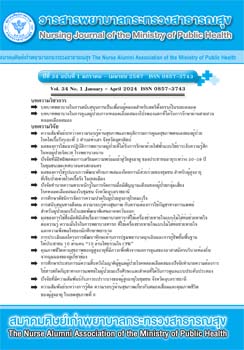Impact of Multimedia about Nursing Care for Infant Received Non-Invasive Respiratory Support on Knowledge, Confidence, and Satisfaction of Nursing Students
Main Article Content
Abstract
Nursing care provided by nursing students to infant patients in a critical condition may lead to a great deal of risks. Therefore, teaching materials to prepare the students can be very helpful. This quasi-experimental study employed two-group pretest-posttest design to assess the effects of multimedia intervention on nursing students' knowledge and confidence in caring for infants received non-invasive mechanical ventilation (NIV) without intubation. Participants were selected using cluster random sampling from the students enrolled in Child and Adolescent Nursing Practice II. The total participants consisted of 48 students divided into two groups. The control group of 24 students received supplementary reading materials and a practical training manual as usual preparation activities, while the experimental group of 24 students received the same documents and additional multimedia materials for their preparation activities. Data were analyzed by inferential statistics, including paired t-test to examine the differences of mean scores within groups, and independent t-test to examine the differences of mean scores between groups. The results demonstrated that both the experimental and control groups showed the significantly improved mean scores of knowledge and confidence in nursing practice for infants on NIV without intubation after the preparation activities. Concerning the effect of the multimedia material, it was found that the experimental group displayed the significantly higher mean scores of knowledge and confidence compared to the control group. These findings suggest that the multimedia material can enhance knowledge and increase confidence among nursing students during their practical preparation to provide nursing care for infants on NIV without intubation. This may help reduce errors from nursing students' practice in real situations.
Article Details

This work is licensed under a Creative Commons Attribution-NonCommercial-NoDerivatives 4.0 International License.
บทความและรายงานวิจัยในวารสารพยาบาลกระทรวงสาธารณสุข เป็นความคิดเห็นของ ผู้เขียน มิใช่ของคณะผู้จัดทำ และมิใช่ความรับผิดชอบของสมาคมศิษย์เก่าพยาบาลกระทรวงสาธารณสุข ซึ่งสามารถนำไปอ้างอิงได้
References
Sweet DG, Carnielli VP, Greisen G, Hallman M, Klebermass-Schrehof K, Ozek E, Te Pas A, Plavka R, Roehr CC, Saugstad OD, Simeoni U, Speer CP, Vento M, Visser GHA, & Halliday HL. (2023). European Consensus Guidelines on the Management of Respiratory Distress Syndrome: 2022 Update. Neonatology. 2023 Mar 7;120(1):3-23.
Schreiber MD, Marks JD. Noninvasive Ventilation in the Premature Newborn—Is Less Always More?. New England Journal of Medicine. 2017 Jul 27;377(4):386-8.
Boel L, Hixson T, Brown L, Sage J, Kotecha S, Chakraborty M. Non-invasive respiratory support in preterm infants. Pediatric respiratory reviews. 2022 Sep 1;43:53-9.
Guay JM, Carvi D, Raines DA, Luce WA. Care of the Neonate on Nasal Continuous Positive Airway Pressure: A Bedside Guide. Neonatal Network. 2018;37(1):24–32.
Iyer NP, Chatburn R. Evaluation of a nasal cannula in noninvasive ventilation using a lung simulator. Respiratory Care. 2015;60(4):508–12.
Bashir T, Murki S, Kiran S, Reddy VK, Oleti TP. Nasal mask in comparison with nasal prongs or rotation of nasal mask with nasal prongs reduce the incidence of nasal injury in preterm neonates supported on nasal continuous positive airway pressure (nCPAP): A randomized controlled trial. PLoS One. 2019;14(1): e0211476.
Esmaeilnia T, Nayeri F, Taheritafti R, Shariat M, Moghimpour-Bijani F. Comparison of complications and efficacy of NIPPV and nasal CPAP in preterm infants with RDS. Iran Journal Pediatric. 2016;26(2).
Pummanee T, Suwannawat J, Buatchum K, Nukaew O, Suwanchinda P, Worrasirinara P. Effect of Instructional Video for Mental Status Examination Collaborate with Case-Based Learning on Knowledge, Self-efficacy, and Satisfaction in Psychiatric Practice among Undergraduate Nursing Students. J Res Nurs-Midwifery Health Sci. 2023;43(1):67–79. (in Thai)
Siricharoenwong K, Mataputana M, Sawangjid S, Pidjadee C. Development and effectiveness of video media to knowledge, self-confidence and satisfaction of nursing students in preparation for children and adolescence care practicum experience. J Health Nurs Res J Boromarajonani Coll Nurs Bangk. 2021 Apr 9;37(1):218–29. (in Thai)
Raksatham S, Wattanachai P, Noothong J. The development of video lesson on oxygen therapy in children for nursing students at Boromarajonani College of Nursing, Bangkok. J Health Nurs Res J Boromarajonani Coll Nurs Bangk. 2019;35(3):185–98. (in Thai)
Boromarajonani College of Nursing Uttaradit. Field experience specification child and adolescent nursing practicum II. Boromarajonani College of Nursing Uttaradit: Facuty of Nursing, Praboromarajchanok Institute; 2021 Jul. (in Thai)
Bloom BS, Engelhart MD, Furst EJ, Hill WH, Krathwohl DR. Taxonomy of educational objectives. New York: Longmans, Green; 1964.

